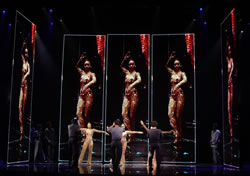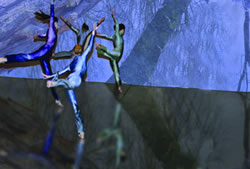Commissions
Collective Strategies in the State of the Art
One of the essential offerings for using projections in live performances at Kansas City 2010 Conference & Stage Expo, the Broadway Seminar on Projection Design, was informative, timely, and on target regarding the current state of the art. It set the stage for many discussions on the design and use of projection technology in live productions.

Context: Scene Location: Photo Session - one girl that is on live camera and sent to all screens.
Projection Designer: Howard Werner
Photo courtesy: Lightswitch
One of the principle designers representing Lightswitch, Howard Werner, provided a breadth of historical context as well as anecdotal details regarding his work mapping out milestones like Say Goodnight Gracie, Bye Bye Birdie, Dreamgirls, and the forthcoming Spiderman. Adding to the historical discussion, Michael Clark offered additional anecdotal highlights regarding his early introduction as a project manager of projected media.
Mr. Clark’s critical work with Wendell Harrington (Tommy) provided some grounding in what must be viewed as a pioneering learning-curve. Tommy’s grid system, comprising more than 50 archaic projector stacks, including overheated machines with carousels holding thousands of slides that often didn’t advance), served as an example of the art form in 1993. So without discounting Louis Daguerre’s contributions as precursor, or more accurately counting Josef Svoboda as the true first generation, Clark and Werner are of a third generation of designers.
As a result of the industry’s natural evolution, which included advances in instrumentation, digital HD video, and LED screen technology, projection technology has come a long way in the 17 years since Tommy. Almost two decades ago, the industry was comprised of a small community of New York City-based collaborators. Projection is now the discipline-inclusive option that is part of the discussion on day one of any production. As a result, it is no coincidence that designers are consistently interacting with audiences who are anticipating, if not demanding, that a filmic component be integrated into live narrative art forms.

“Humankind” 2009 Projection slide
Choreographer: Mary Lynn Babcock
Projection designer:
Kenneth Verdugo
Photo courtesy: Kenneth John Verdugo
The conference offered Projections 101 as a basic primer on “start-up” processes promoting integrated projected imagery in theatrical production. Another member of Lightswitch, Jason Lindahl, presented an overview of some of the most high-end software currently used in theatrical, architectural, and entertainment projects in the United States. Randy deCelle, Fisher Technical Services, and Aaron Bollinger, FSU, provided fundamentals on topics ranging from resolution to pixels, and lumens to lenses, including relative cost break-downs. As a counterpart, professors Mary Lynn Bacock and Kenneth John Verdugo of the University of North Texas, provided personal accounts related to the overlapping distribution of responsibilities. Their discussion focused on the complex working arrangement between a graphic designer (image maker) working in conjunction with a tech-savvy choreographer (co-designer), both intimately engaged in digital processing. Broadway Seminar on Projection Design Chair Charles Otte identified the current art form as a “discipline... forcing designers and directors [production teams] to engage in closer collaboration.”
The unifying sub-text linking these sessions together centered on the introduction of new and developing strategies in communications and teamwork; an idea clearly represented at Friday’s offering, Long Distance Relationships from Afar. Session Chair Rob Eastman-Mullins pulled together a group of designers who are each comfortably engaged with a mixture of long-proven methods as well as new or evolving social networking tools. It is perhaps surprising, at this moment in the art’s history, that so many still shy away from engaging designers from outside their own region, town, or building for fear that the ideal conditions cannot exist without everyone in the room.
![]() To that end, 5D Immersive Design was, in part, invented as a vehicle to grow a more efficient,
unifying model. In its genesis, 5D originated from within the matrix of gaming technology and film production
needs and expanding broadly and inclusively by pulling from the ranks of
theatre, art, and hard science investigators. At Wednesday’s groundbreaking
session, attendees learned that Don Marinelli and his cohorts -- Michael
Devine, David Taylor and Thomas A. Walsh -- are intent to rebuild anew processing
and collectively working.
To that end, 5D Immersive Design was, in part, invented as a vehicle to grow a more efficient,
unifying model. In its genesis, 5D originated from within the matrix of gaming technology and film production
needs and expanding broadly and inclusively by pulling from the ranks of
theatre, art, and hard science investigators. At Wednesday’s groundbreaking
session, attendees learned that Don Marinelli and his cohorts -- Michael
Devine, David Taylor and Thomas A. Walsh -- are intent to rebuild anew processing
and collectively working.
For a thorough discussion on 5d, visit Pan Leung’s article in a previous issue of Sightlines.
As interdependent industries retool the way they engage each other, a shared use of ideas and tools helps redefine how stories are told and created.


